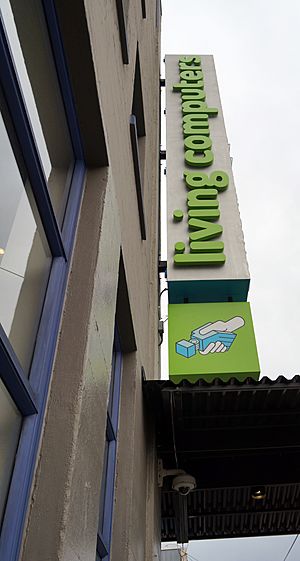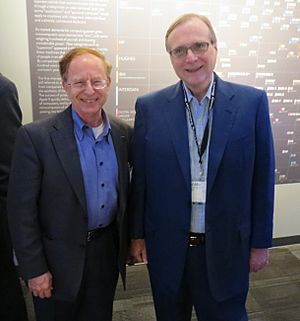Living Computers: Museum + Labs facts for kids
 |
|

Exterior of the museum
|
|
| Established | October 25, 2012 |
|---|---|
| Dissolved | February 2020 |
| Location | 2245 1st Avenue South Seattle, Washington, U.S. |
| Type | Computer museum |
| Key holdings | PDP-10, IBM Mainframes, Apple 1, PLATO |
| Founder | Paul Allen |
| Public transit access | King County Metro, Link light rail |
| Nearest car park | Onsite and Street Parking |
Living Computers: Museum + Labs (often called LCM+L) was a special museum in Seattle, Washington. It focused on computers and technology. Unlike many museums, LCM+L let visitors actually use old computers. You could interact with them online or in person.
The museum also had new technology exhibits. These included self-driving cars and robotics. LCM+L wanted people to experience how computers worked. They aimed to "breathe life back into our machines." This meant you could see, hear, and use them.
The museum closed in February 2020. This happened because of the COVID-19 pandemic. In June 2024, it was announced that the museum would not reopen. Many of its items were sold at an auction.
History of the Living Computers Museum
The Living Computers: Museum + Labs was started by Paul Allen. He was a co-founder of Microsoft. The museum first opened on January 9, 2006. It was first known as PDPplanet.com. Later, it became the Living Computer Museum.
At first, people could connect to old computers online. They used a method called Telnet. This let them experience "time-sharing" computing. This meant many users could share one computer at the same time.
The museum opened its doors to the public on October 25, 2012. Visitors could come in person. They could interact with many different types of computers. These included large mainframes and smaller microcomputers. The exhibits showed how much technology had changed.
In 2013, a local newspaper called Seattle Weekly named it the "Best Geeky Museum." They said it was important for Seattle's tech history. On November 18, 2016, the museum changed its name. It became Living Computers: Museum + Labs. This new name showed its wider goal. It wanted to spark curiosity about both old and new technology.
The museum closed in February 2020. It never reopened after that. The Paul Allen Estate announced its permanent closure in June 2024. Many items from its collection were then sold.
Museum Collections and Exhibits
The museum's collection included items given by the public. It also had many computers from Paul Allen's own collection. The museum had working computers on display. These included one supercomputer and many mainframes. It also had minicomputers and microcomputers.
Some items from the museum were even used in TV shows. These shows included Mad Men and Halt and Catch Fire.
Types of Computers on Display
The museum had a wide variety of computers. Here are some of the types of computers that were part of its collection:
| Manufacturer | Model | Type | Year Introduced | Available for public use | Telnet access |
|---|---|---|---|---|---|
| Amazon | Kindle 1 | hand-held | 2007 | Yes | No |
| Amiga | 500 | microcomputer | 1987 | Yes | No |
| Apple | Apple 1 | microcomputer | 1976 | Yes | No |
| Apple | II | microcomputer | 1977 | Yes | No |
| Apple | IIe | microcomputer | 1983 | Yes | No |
| Apple | III | microcomputer | 1980 | Yes | No |
| Apple | Lisa 2 | microcomputer | 1984 | Yes | No |
| Apple | iMac G3 | microcomputer | 1998 | Yes | No |
| Apple | Macintosh SE | microcomputer | 1987 | Yes | No |
| Apple | Power Mac G4 | microcomputer | 1999 | Yes | No |
| AT&T | DMD 5620 / 3B2 | minicomputer | 1983 | Yes | Yes |
| Atari | 2600 | video game console | 1977 | Yes | No |
| Atari | 400 | microcomputer | 1979 | Yes | No |
| Atari | 1040 ST | microcomputer | 1985 | Yes | No |
| Columbia Data Products | MPC 1600 | microcomputer | 1982 | Yes | No |
| Commodore | PET | microcomputer | 1977 | Yes | No |
| Commodore | 64 | microcomputer | 1982 | Yes | No |
| Compaq | DeskPro 386S | microcomputer | 1989 | Yes | No |
| Compaq | Portable | microcomputer | 1983 | Yes | No |
| Control Data | CDC 6500 | supercomputer | 1967 | No | Yes |
| Control Data | DD60 monitor | operator console | 1964 | No | No |
| Control Data | 405 card reader | peripheral | 1964 | No | No |
| Control Data | CDC 679-6 magnetic tape transport | peripheral | 1964 | No | No |
| Cray | Cray-1 | mainframe | 1975 | No | No |
| Cromemco | Z-2D | microcomputer | 1978 | Yes | No |
| Data General | Nova | minicomputer | 1969 | Yes | No |
| DEC | PDP-7 | minicomputer | 1964 | No | No |
| DEC | PDP-8/E | minicomputer | 1970 | Yes | No |
| DEC | PDP-10 KA10 (DECsystem-10) | mainframe | 1968 | No | No |
| DEC | PDP-10 KI10 (DECsystem-10) | mainframe | 1971 | No | No |
| DEC | PDP-10 KL10 (DECSYSTEM-2065) | mainframe | 1974 | Yes | Yes |
| DEC | PDP-10 KL10 (DECSYSTEM-1095) | mainframe | 1974 | Yes | Yes |
| DEC | PDP-10 KS10 (DECSYSTEM-2020) | mainframe | 1979 | Yes | Yes |
| DEC | PDP-11/70 | minicomputer | 1975 | Yes | Yes |
| DEC | PDP-12 | minicomputer | 1969 | No | No |
| DEC | VAX-11/780-5 | minicomputer | 1982 | Yes | Yes |
| DEC | VT131 | terminal | 1981 | Yes | No |
| Dell | Dimension XPS B733 | microcomputer | 1999 | Yes | No |
| E.S.R. | Digi-Comp II reproduction | toy computer | 1965 (original patent); 2012 (reproduction) | Yes | No |
| Honeywell | 6180 DPS-8/M maintenance panel and Multics emulator | peripheral; emulation of mainframe | 1973 (mainframe) | No | No |
| IBM | System/360 Model 30 mainframe | mainframe | 1964 | No | No |
| IBM | System/360 Model 91 front panel | peripheral | 1966 | No | No |
| IBM | 029 card punch | peripheral | 1964 | Yes | No |
| IBM | 4361 | mainframe | 1983 | Yes | Yes |
| IBM | Personal Computer 5150 | microcomputer | 1981 | Yes | No |
| IBM | PCjr | microcomputer | 1984 | Yes | No |
| IBM | PC/AT | microcomputer | 1984 | Yes | No |
| IMLAC Corporation | PDS-1 "sImlac" emulator | emulation of minicomputer | 1970s (minicomputer); 2017 (emulator) | Yes | No |
| IMSAI | 8080 | microcomputer | 1975 | Yes | No |
| Interdata | 7/32 | minicomputer | 1974 | Yes | Yes |
| MITS | Altair 8800 | microcomputer | 1975 | Yes | No |
| Microsoft | PixelSense | microcomputer | 2007 | Yes | No |
| NeXT | NeXTcube | microcomputer | 1990 | Yes | No |
| Nintendo | NES-101 | video game console | 1993 | Yes | No |
| Osborne | Executive | microcomputer | 1982 | Yes | No |
| PLATO | Terminal V | microcomputer | 1976 | Yes | No |
| Processor Technology | Sol-20 | microcomputer | 1976 | Yes | No |
| Radio Shack | TRS-80 Model 4 | microcomputer | 1983 | Yes | No |
| Sun Microsystems | 3/160 | microcomputer | 1986 | Yes | No |
| Tandy | 1000 | microcomputer | 1984 | Yes | No |
| Tandy | Color Computer 3 | microcomputer | 1986 | Yes | No |
| Teletype | Model 33 | terminal | 1963 | No | No |
| Teletype | Model 35 | terminal | 1963 | No | No |
| Teletype | Model 37 | terminal | 1968 | No | No |
| Texas Instruments | Speak & Spell Compact | hand-held | 1982 | Yes | No |
| Texas Instruments | TI-99/4A | microcomputer | 1981 | Yes | No |
| Xerox | Sigma 9 | mainframe | 1971 | Yes | Yes |
| Xerox | Alto | minicomputer | 1973 | Yes | No |
| Xerox | Alto "ContrAlto" simulator | emulation of minicomputer | 1973 (minicomputer); 2016 (emulator) | Yes | No |
| XKL | TOAD-1 | mainframe | 1995 | Yes | No |
| XKL | TOAD-2 | mainframe | 2005 | Yes | Yes |



